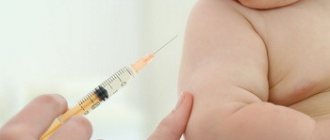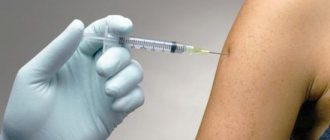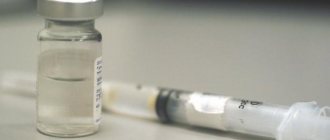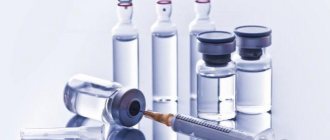The BCG-M vaccination is a lightweight version of the drug used to prevent tuberculosis. This problem is especially relevant in Russia, where children under 4 years of age are at risk, so their primary vaccination is carried out immediately after birth. In special cases, BCG-M is used for this, which replaces the usual drug and has a similar effect on the body. It is important for parents to know in what situations it is worth paying attention to this particular medicine, and how it differs from the usual vaccine.
All about the BCG-M vaccination
BCG-M can be used for primary vaccination and revaccination of young children if there are contraindications for the use of a conventional drug. It is named after the developers of the drug, the decoding of the Latin name BCG (bacillus Gelmette–Guerin) is translated as bacillus Calmette-Guerin. The letter M in this case denotes a modification, a means of weakening the effect on the body.
The vaccination has a gentle effect on the weakened child’s body, but its effect is no less effective and is aimed at producing antibodies to fight tuberculosis in the initial stages. This vaccination is not mandatory, but is recommended to prevent future infection.
Now there are many manufacturers of such drugs. However, according to the World Health Organization, the best are:
- NPO Microgen in Russia.
- Statens Serum Institut (State Serological Institute) in Denmark.
- Sanofi-Aventis Group in France.
- Japan BCG Laboratory in Japan.
Although other worthy companies can be noted, in the Russian Federation it is the medications produced by the first two institutes that are used.
Revaccination with BCG
Healthy children, adolescents and adults of pre-term age who have a negative Mantoux reaction with 2 TE PPD-L are subject to revaccination.
The interval between the Mantoux test and revaccination should be at least 3 days and no more than 2 weeks.
The first revaccination of children (vaccinated at birth) is carried out at the age of 6-7 years (1st grade students).
II revaccination – at the age of 14-15 years (9th grade students), as well as for adolescents of secondary specialized educational institutions (vocational schools, technical schools) in the first year of study. In regions unfavorable in terms of the epidemiology of tuberculosis (the main epidemiological indicators are higher than the federal average), revaccination is carried out at inter-decreed ages for children and adolescents who do not have post-vaccination signs, 2 years after vaccination and 1 year after the previous revaccination. At the same time, revaccination of children and adolescents who had temporary medical exemptions from vaccinations at decreed ages is carried out.
Revaccination of adults (18-30 years old) is carried out in organized groups (students of vocational schools, technical schools, university students, employees of large enterprises and organizations, conscripts). Revaccination of adults with a negative and questionable Mantoux reaction with 2 TE PPD-L.
Revaccination with BCG and BCG-M vaccines can be carried out using the needle-syringe method (disposable or reusable syringes and needles are used) or using needle-free injectors - BI-1M; BI-19 with anti-infective protectors (PIP-1). It is necessary to have 2 sets of needle-free injectors (one for tuberculin diagnostics, the other for revaccination).
Differences between BCG-M and BCG
The BCG and BCG-M vaccinations do not have clearly defined differences, because they have the same method of administration and characteristics of the effect on the body, and even their composition is similar, although some distinctive features are present in each of them. These differences are shown in the following table.
| BCG | BCG-M | |
| Year of development | 1908 - beginning of research, 1921 - first application | Proposed for vaccination in 1985 |
| Indication | Prevention of tuberculosis | |
| Active substance | Mycobacteria bovis | |
| Dosage | 0.05 mg microbacteria and 0.3 mg monosodium glutamate as stabilizer | 0.025 mg Mycobacterium Bovis, 0.1 mg MSG |
| Purpose | 3–7 days after birth, at 7 and 14 years old | At the same time, but if you need a lighter form |
| Features of use | For healthy children with no contraindications | For premature children, not vaccinated on time, at risk of complications and Rh conflict with the mother |
| Newborn weight | Over 2.5 kg | 2–2.5 kg |
| In case of acute and severe illnesses, immunodeficiency, underweight | Not applicable | Vaccination is possible after the baby has been cured or gained weight. |
| Neurological diseases | It's not possible in any case | Possible for mild deviations |
| HIV positive mother | Not applicable | Possible at 18 months if the child has no infection |
| Conditions at the place of residence | Recommended in epidemiologically unfavorable areas | Can be used in regions that are not at risk |
As you can see, the difference between them is small, and for the most part consists in the dosage of the drug: BCG-M includes only half of the living mycobacteria of the bovine tuberculosis bacillus, due to which it has a more gentle effect on a weakened body.
The truth about the composition of vaccines
Home / Vaccines / The truth about the composition of vaccines /
BCG vaccination
There is a widespread opinion among mothers and doctors that the BCG vaccination must be done, and it is better to refrain from other vaccinations. However, in reality it turns out that this is another misconception and this vaccine is no less dangerous than the others.
First, you should ask what the side effects and composition of this vaccine are:
During BCG vaccination, mycobacteria BCG (live) are administered. They can take root in the body and gradually reduce the already weak immunity of modern children. In many countries around the world, tuberculosis vaccination is prohibited due to its danger and uselessness.
Complications after BCG may be the following:
BCG osteomyelitis,
generalized lymphadenopathy (0.73% of vaccinated people),
lymphadenitis (damage to the lymph nodes; 3.4% of vaccinated people),
disseminated BCG infection,
lupus,
an increase in the number of childhood leukemias, acquired immunodeficiency syndromes (AIDS),
rheumatoid arthritis,
diseases of the kidneys, thyroid gland,
disorder of the nervous, endocrine and vascular systems. [4,3,12]
Today, Russia ranks one of the first places in the world in terms of the largest percentage of children suffering from tuberculosis: every year about 2.5 thousand children suffer from an active form of tuberculosis, although everyone is vaccinated. The instructions included with the BCG vaccine (for tuberculosis) contain 9 contraindications, incl. birth trauma (in almost all children), hemolytic disease of the newborn (may appear much later), congenital enzymopathy (may appear a year later), immunodeficiency states (no one evaluates them).
More details about the components:
Merthiolate or Thimerosal - “an organomercury compound (mercury salt), otherwise called sodium ethylmercury thiosalate, refers to pesticides” (with) Ph.D. Dr. N.N. Mikhailov, toxicologist. (B.I. p. 263) NOBODY has NEVER conducted studies designed to evaluate the consequences of administering merthiolate to children.
Formalin is a potent mutagen and allergen. Allergenic properties include: Quincke's edema, urticaria, rhinopathy (chronic runny nose), asthmatic bronchitis, bronchial asthma, allergic gastritis, cholecystitis, colitis, erythema and skin cracks, etc. NO ONE has EVER conducted studies designed to evaluate the consequences of administering formaldehyde to children.
Phenol – Also known as carbolic acid, it is considered one of the strongest cellular (protoplasmic) poisons. Phenol is known to suppress immune reactions by blocking the phagocytic response. In toxic doses, it can cause convulsions, heart and kidney failure. NOBODY has NEVER conducted studies designed to evaluate the consequences of even a single, let alone multiple, administration of phenol to children.
Tween-80, aka polyoxyethylene sorbitol monooleate, aka polysorbate-80. One study reports that it has estrogenic activity - when administered by intraperitoneal injection to newborn female rats on days 4-7, it produced estrogenic effects... some of which were observed many weeks after drug use was stopped. Research... NOBODY and NEVER...
Aluminum hydroxide The widespread use of aluminum hydroxide in the past is considered a disaster. The toxicity of aluminum came to light only after the toxic effects of aluminum hydroxide became apparent. Stetsyuk E.A. Let us note that for many decades it has not been recommended (!) to use this adjuvant for vaccinating children (writes G.P. Chervonskaya). Research…. NOBODY and NEVER...
About BCG and Mantoux
Particularly dangerous are the vaccinations that are given by default to all newborns in the maternity hospital, in particular the BCG vaccination against tuberculosis.
The World Health Organization itself - WHO - admits that “even in highly endemic areas, the number of cases is only one percent,” that is, out of 100 children born, only one will be susceptible to this infection. And everyone is vaccinated!
But BCG is a notorious vaccine, responsible for several horrific cases of mass death of children. By introducing live mycobacteria parenterally to newborns, and even with a whole “bouquet” of accompanying poisons, doctors greatly undermine the health of infants, causing severe reactions from the lymphatic system - up to leukemia and leukemia.
In addition, the BCG vaccine itself is considered extremely ineffective. It has never fulfilled and cannot fulfill its direct purpose: to protect children from tuberculosis. This vaccine does not prevent a child from becoming infected if he or she comes into contact with a sick person. Moreover, with the help of BCG we spread tuberculosis and accumulate it over generations. Once a vaccinated baby enters the body, mycobacteria settle in it, and the person becomes tubinfected.
Immunologists have long known: if you take a live vaccine against tuberculosis - BCG, add to this the child’s susceptibility to tuberculosis and his weakened immune system, then we can guarantee the appearance of this disease in the child.
According to the head of the department of phthisiology and pulmonology of Donetsk State Medical University, prof. Noreiko, a history of BCG vaccination does not improve, but rather worsens, the prognosis of “normal” tuberculosis. If previously the structure of the incidence of tuberculosis was dominated by benign primary tuberculosis, usually ending in spontaneous recovery, today it is being replaced by secondary tuberculosis - it is secondary because the first encounter with mycobacterium has already occurred in the form of a BCG vaccination. The secondary form of tuberculosis is characterized by a severe course and high mortality.
Nevertheless, money from the budget for such “prevention” for newborns is regularly found - and this despite the annual underfunding of the treatment of tuberculosis patients!
Mantoux test
The tuberculin skin test or the so-called Mantoux test, which is performed annually on our children, does not have a serious scientific basis and does not fulfill its direct task: to identify patients with tuberculosis.
He only states that millions of children in our country became tubercularly infected as a result of the BCG vaccination, which causes the so-called false-positive Mantoux reactions. The Mantoux result itself is measured, as they say, “on your knees,” using a ruler, in millimeters. This is the modern “diagnosis” of tuberculosis!
As a result, a huge number of children are forced to visit tuberculosis dispensaries, where they are exposed to radiation in the X-ray room and far from harmless “preventive treatment.” In addition, a TB doctor will not do anything to improve a child’s immunity: he will not improve his nutrition, will not reduce his school load, will not relieve stress. On the contrary, to all this he will add “precautionary” chemotherapy treatment - a new severe stress for the child’s immune system.
The tuberculin itself, which is used to perform the Mantoux test, is obtained from the filtrate of tuberculous mycobacteria, which, under unfavorable conditions, can themselves serve as a trigger for the development of tuberculosis.
In addition, according to the annotation, tuberculin (biological product Tuberosol) contains Tween-80 (0.0005%) as a stabilizer and phenol (0.28%) as a preservative. Phenol, also known as carbolic acid, is considered one of the strongest cellular poisons, and all the talk about its supposed “harmlessness in such a low concentration” is nothing more than fortune telling on coffee grounds, because no one has ever conducted relevant research. But phenol’s ability to suppress immune reactions by blocking the phagocytic response is well known, and in toxic doses it can cause convulsions, heart and kidney failure. About the stabilizer with the modest name “Tween-80”, also known as polyoxyethylene sorbitol monooleate, it is reported that it has estrogenic, i.e. hormonal activity, and therefore can influence early puberty.
Naturally, the drug “Tuberosol”, like almost all vaccines, was not tested for either carcinogenic or mutagenic potential.
At its core, the Mantoux test is nothing more than a chemical reaction using pesticides, and this reaction is carried out not in a test tube, but inside the child’s body!
But in the world there are already fundamentally new tests for detecting tuberculosis - in vitro, i.e. in vitro.
In June 2004, European countries approved a new, incomparably more accurate test for the presence of tuberculosis, based on the study of T-cell responses in blood serum. However, this is probably unacceptably expensive for our country, and we still use “advanced” technologies of the 19th century in tuberculin diagnostics!
According to Galina Chervonskaya, the current practice of this “diagnostic” test - the Mantoux test - is “a striking example of the absurd action of the domestic Ministry of Health, lack of knowledge, active imitation of the “no alternative” method and reluctance to delve into the problem given the monopoly right of vaccinators to irresponsibly risk the health of the nation.”
We recommend the latest news
- Vaccines 05/01/2020
New vaccine technology being tested in humans
- Vaccines 12/22/2018
Vaccinationgate
- Vaccines 07/25/2019
The danger of rotavirus infection has been greatly exaggerated
- Vaccines 09.11.2018
The vaccination lobby in the Ministry of Health intends to expand the vaccination calendar
- Vaccines 06/27/2019
People who are vaccinated against flu are more likely to spread the flu than people who are not vaccinated.
- Vaccines 06.11.2018
Fifty reasons to protect your child from vaccinations
Indications for use
You can vaccinate with BCG-M in the following cases:
- the child was born prematurely;
- underweight in a newborn;
- tendency to allergic reactions;
- the period after infectious or chronic diseases due to which the main injection was cancelled;
- mismatch of Rh factors between the baby and the mother;
- the presence of mild neurological disorders;
- there are birth injuries, anemia;
- the usual vaccination was not given on time;
- with revaccination at 7 and 14 years of age after receiving the Mantoux result;
- there is no serious risk of disease in this region of residence.
Administration of the drug is often necessary in adulthood, especially in the following situations:
- for those who were in contact with a patient with tuberculosis;
- there is a negative Mantoux test in military personnel, detainees and other categories of citizens under the age of 30;
- There are no certificates of vaccinations and it is impossible to determine their presence.
Before this, a consultation with a TB doctor is required, who will determine the need for vaccination and tell you about all the necessary measures before and after vaccination.
When is BCG given to adults?
Adults can receive a tuberculosis vaccine up to the age of 30 if the Mantoux test shows a negative result and there are no contraindications. For revaccination there must be no previous disease. Immunization is mandatory for people who do not have documents about previous vaccination. Before the procedure, a Mantoux test with 2TE is performed. In case of a negative reaction, revaccination is done after three days, but not later than two weeks.
Article on the topic: Enterovirus infection - causative agent and routes of transmission, symptoms, diagnosis, treatment methods and prevention
Components and release of the vaccine
BCG-M contains Mycobacterium Bovis, which is a strain of BCG-1, or bovine tuberculosis bacillus bacteria grown in an artificial environment. They are filtered and purified, creating a concentrated and safe product for the human body. When vaccinated, it mimics the development of a mild form of tuberculosis to produce specific antibodies.
These antibodies remain in the blood, forming a person’s immunity to tuberculosis bacilli. This is how the development of the disease is prevented, if there are prerequisites for this. In case of serious spread of the tuberculosis bacillus, antibodies will alleviate the course of the disease, but additional actions will be required for a cure.
BCG-M is produced in vacuum ampoules with a white powdery substance inside. A dose of 0.025 mg of mycobacterium tuberculosis is lyophilized (dried in a special way) in a 1.5% solution of monosodium glutamate, of which 0.1 mg is taken. There are 20 of them in one ampoule, which corresponds to 0.5 mg of the substance. Before use, the powder is dissolved in a 0.9% sodium chloride solution (0.5 mg per 2 ml of solvent).
What is included in the BCG vaccine?
The drug for tuberculosis BCG was created by French scientists A. Calmette and C. Guerin in 1921. They identified several subtypes of microorganisms that cause infectious dangerous diseases. Since then, the composition of the vaccine has remained unchanged. The list of components needed to prepare the vaccine is kept by WHO.
The main active components are several types of Koch bacilli. Their amount depends on the specific technology of creating the drug, but, as a rule, it is 0.05 mg.
About 90% of BCG contains one of the following strains of bacteria:
- French "Pasteur" 1173 P2.
- Danish 1331.
- Strain "Glaxo" 1077.
- Tokyo 172.
Each vaccine, regardless of the type of strain present in it, is highly effective. There is also a BCG-M vaccine. The concentration of active ingredients in it is halved. It is used when there are contraindications to the standard BCG drug.
In addition to pathogenic microorganisms, the vaccine also contains additional components:
- formalin;
- twin-80;
- aluminum hydroxide;
- merthiolate.
These elements are classified as toxic. But their concentration in the drug is negligible. Therefore, they are not capable of harming the body. In addition, there is no official confirmation of the presence of such components in BCG. The vaccine kit contains a sodium chloride solution. The mycobacterial composition is mixed with this substance before administration.
Imported and domestically produced tuberculosis vaccines are created using similar technology.
Application
When vaccinating, you should follow the instructions and recommendations of specialists, including the following:
- up to 2 months of age, a child is vaccinated in a maternity hospital or clinic without diagnostic measures;
- after 2 months you need to do a Mantoux test, and only 3–21 days after it, give BCG-M if the result is negative.
According to the scheme, the drug is administered to a newborn, and then revaccination occurs at 7 and 14 years of age. The injection is made into the surface layer of the skin, in the area of the left forearm, pre-treated with alcohol. As a result of correct use of the product, a whitish papule 0.5–1 cm in diameter will appear at the injection site, which will disappear after 15–20 minutes. With primary vaccination, the result will appear in 4–6 weeks, with revaccination – within a week.
Immediately after vaccination, mild local inflammation, suppuration, itching and swelling, and an increase in body temperature may appear, and these are completely normal phenomena. Treating this area with iodine or other means is prohibited, as is bandaging, washing, or simply getting water on it.
Normal reaction to BCG
After the vaccine injection, a papule measuring 5–10 mm is formed; after 20 minutes this white spot disappears. For diagnosis, “turn” is also important - an increase in the size of the tubercle compared to last year. After two months, a seal similar to a mosquito bite appears at the site where the injection was made. Then an ulcer forms there, which can take several months to heal. After this, a scar with a diameter of 2 to 10 millimeters appears at the injection site. All this is normal during the development of the reaction and should not cause concern.
BCG vaccination turned red
After the vaccine is administered, the injection site will turn red and suppuration may occur. All this is the norm. After suppuration, the injection site may still be red. Under normal circumstances, redness occurs only during the body's reaction to the vaccine and should not dissipate. In some cases, a keloid scar appears at the injection site, the skin becomes red and swells, which is a reaction to BCG and does not pose any danger. When active healing occurs, the area itches.
Article on the topic: Cataract - symptoms and first signs of the disease, diagnosis, treatment methods and preventive measures
Fever after vaccination
During the vaccination reaction, while an abscess forms at the injection site, an increase in temperature may be noted. It occurs rarely and is not significant. Thus, in children, the temperature in such cases does not go beyond 37.5 °C. The reaction to vaccination can be marked by temperature fluctuations from 36.4 to 38 °C. If a 7-year-old child has a fever after vaccination, contact a doctor immediately.
BCG vaccination festers
The formation of an abscess is a normal reaction to the BCG vaccination. With a crust in the center, it should not have redness or swollen tissue around it. If there is swelling around the suppurating injection site, you should visit a doctor, as the wound could become infected and will require treatment. There are also cases when the site after vaccination is subjected to suppuration several times, which means the presence of BCGitis, the treatment of which should be carried out by specialists. The child should be examined, and other vaccinations should not be performed until the problem is resolved.
Contraindications
Contraindications to the use of BCG-M vaccination include:
- presence of severe infectious diseases;
- immunological deficiency;
- HIV infection;
- existing or past tuberculosis;
- presence of diabetes, kidney problems;
- complicated BCG in family members;
- tendency to allergies to constituent substances;
- the presence of neoplasms, radiation therapy;
- severe neurological manifestations;
- weight up to 2 kg in a newborn;
- intrauterine, skin pathologies in a child;
- use in therapy of drugs that weaken the immune system (immunosuppressants, corticosteroids).
In adults, caution should be exercised regarding vaccination during pregnancy, in the presence of cardiovascular lesions, and also if complicated reactions to the drug were previously present, or positive Mantoux tests. Before vaccination and during the post-vaccination period, diagnostics and consultation for children can be carried out by a neonatologist (examines newborns) or a pediatrician, and adults can be examined by a phthisiatrician who treats tuberculosis.
Evaluation of vaccination results
The effectiveness of vaccination in newborns is indicated by the scar formed after administration of the drug. The skin scar is assessed after 6 months. Normally, the scar should be from 3 to 10 mm long. The formation of such a scar indicates successful vaccination and developed immunity.
Useful: Should children be given vitamin D, when and in what quantity?
When the grafting is not very successful, a scar does not form or becomes barely noticeable above the skin. What do they do in this case? A Mantoux test is performed and the issue of re-vaccination is decided. The final decision is made after a complete examination of the small patient by an infectious disease specialist.
Complications
The result of improper vaccination can be complications in which the following symptoms appear:
- body temperature rises above 380;
- cough, runny nose, weakness and other signs of a cold;
- decreased activity, lethargic state.
In such cases, you should consult a doctor, and in order to avoid keeping an eye on the child while bathing, prevent him from catching an infection and monitor his general well-being in order to see a doctor in time.
The above symptoms may indicate the occurrence of negative consequences in the form of:
- cold abscess (accumulation of pus without significant inflammation and pain), which appears after 1–1.5 months and requires surgical removal of the fistula;
- the occurrence of an ulcer, which has a diameter of about 1 cm and indicates individual intolerance to the components, requires local treatment;
- lymphatic inflammation when mycobacteria BCG-1 enters the lymph nodes, requiring therapy if they become enlarged;
- keloid scar in the form of severe redness and swelling at the vaccination site, occurs a year after vaccination, and indicates that revaccination with the main drug cannot be carried out;
- osteomyelitis with bone damage and limitation of joint movement, manifests itself 0.5–2 years after administration of the drug, the risk of occurrence is 1/200;
- generalized BCG infection, occurring in 1 person per million, with congenital immunodeficiency, and occurring in a particularly complex form.
Most often, the cause of complicated reactions is incorrect administration of the injection, the presence of contraindications, non-compliance with recommendations and safety precautions. Some parents refuse to vaccinate their children precisely because of this risk. It is worth noting that by doing this they only expose the child to even greater danger, especially if they live in areas with a high probability of contracting tuberculosis. To avoid unpleasant moments, if you have doubts about the need for vaccination, you should insist on diagnostic steps before it is carried out, and also carefully monitor your child in the post-vaccination period.
Tuberculosis vaccination schedule
Children whose parents have given consent to vaccination are given the BCG vaccine in the maternity hospital on days 3-7. In most cases, this procedure is performed on the day the newborn is discharged, provided he is in good health. Vaccination is not given if there are certain contraindications or if parents refuse to vaccinate their child. Also, BCG is not administered simultaneously with other vaccinations, with the exception of the hepatitis B vaccine.
Vaccination is carried out in the treatment room or directly in the ward. The standard site for injection of the drug is the area of the left shoulder, at the site of the deltoid muscle. The vaccination is done at the border of the upper and middle third of the shoulder intradermally. It is not allowed to administer the drug subcutaneously or intramuscularly!
After a short time, a small spot appears at the injection site - no larger than a mosquito bite. This condition is completely normal and indicates that the drug has begun its work. Subsequently, the spot turns into a vesicle, which opens to form an ulcer. Over time, the ulcer heals, leaving a barely noticeable scar on the skin of the shoulder. This skin reaction is considered a common occurrence and further allows us to judge the effectiveness of the vaccination.
Advice
Does the ulcer not heal after vaccination? Consult a doctor!
Features of the body's reaction to intradermal
BCG vaccination and revaccination
The BCG vaccine, administered by any method, never causes pronounced specific changes and does not have a toxic effect on the nervous system of vaccinated individuals; the general condition of those vaccinated with BCG remains good, the temperature is normal.
It has now been proven that in vaccinated children, as well as in experimental animals, histological examination can reveal morphological paraspecific and small specific changes, localized mainly in the lymph nodes and less often in other organs.
V.I. Puzhik (1844) histologically discovered in the organs of vaccinated children who died from non-tuberculosis diseases the proliferation of lymphoid elements, small specific changes in the lymph nodes, as well as the reaction of the reticuloendothelial system of the liver, spleen and lungs. These changes were reversed after 12 months, since they were not detected in children at one year of age.
The immunological restructuring of the body under the influence of the BCG vaccine is primarily accompanied by the appearance of positive tuberculin sensitivity.
Immunity from BCG vaccination occurs in approximately 1.5-2 months. after the introduction of the BCG vaccine into the body. For this period, it is necessary to isolate persons living in contact with a patient with bacillary tuberculosis. It is especially important to carry out this activity in newborns, since primary tuberculosis in young children is more severe than in older children.
Should I do it?
Tuberculosis is a dangerous infectious disease that a child can contract anywhere, and unvaccinated children are at risk for contracting the disease. If the injection was not given to the newborn in the maternity hospital, it is recommended that the procedure be performed as soon as possible.
Slight inflammation, redness and the formation of an abscess on the skin should not cause concern, since such reactions indicate the formation of anti-tuberculosis immunity.
If the indicators are not within normal limits, you should consult a doctor as soon as possible - timely medical care will help avoid serious complications.
Today, anti-tuberculosis vaccination is the only method of protecting a child from infection with a dangerous disease, so parents should not neglect this procedure. If the vaccine is administered correctly, there are no contraindications and all rules for caring for the injection site are followed, the drug is absolutely safe for the child’s health.
Toward revaccination of children, adolescents and adults
| Nosological form | Admissibility of vaccinations |
| 1. Infected with tuberculosis or tuberculosis in the past 2. Positive or questionable Mantoux reaction with 2 TE PPD-L 3. Complicated reactions to the previous administration of the BCG or BCG-M vaccine (keloid scars, lymphadenitis, etc.) 4. Acute diseases (infectious and non-infectious), including the period of convalescence, chronic diseases in the acute stage or decompensation 5. Allergic diseases (skin and respiratory) in the acute stage 6. Malignant blood diseases and neoplasms 7. Immunodeficiency states. Treatment with immunosuppressants. 8. Pregnancy (all periods) | Contraindicated Contraindicated Contraindicated Vaccinations are carried out no earlier than 1 month after recovery (remission) After recovery or achievement of remission according to the opinion of specialists Contraindicated According to the conclusion of a specialist after an immunological study Contraindicated |
Note: in case of contact with infectious patients in the family, child care facility, etc. Vaccinations are carried out at the end of the quarantine period or the maximum incubation period for a given disease.
Persons temporarily exempt from vaccinations should be placed under observation and registration and vaccinated after full recovery or removal of contraindications. If necessary, appropriate clinical and laboratory examinations are carried out.
Other preventive vaccinations can be carried out at an interval of at least 2 months before and after revaccination with BCG and BCG-M.
Complications of BCG
Currently, the classification of post-vaccination complications proposed in 1984 is in effect. International Union Against Tuberculosis WHO. Complications are divided into 4 categories:
Category 1 – local skin lesions (cold abscesses, ulcers) and regional lymphadenitis;
Category 2 – persistent and disseminated BCG infection without lethal outcome (lupus, osteitis, etc.);
Category 3 – disseminated BCG infection, a generalized lesion with a fatal outcome, which is observed in congenital immunodeficiency;
Category 4 – post-BCG syndrome (manifestations of the disease that arose shortly after BCG vaccination, mainly of an allergic nature, erythema nodosum, rashes, etc.).
In our country, complications of vaccination, revaccination of BCG, BCG-M are usually local in nature and are observed relatively rarely (0.02%, 0.004% of vaccinated newborns and 0.001%, 0.0001% of revaccinated children and adolescents).
Complications are considered: subcutaneous cold abscesses; ulcers 10 mm or more in diameter at the site of intradermal injection of the vaccine; lymphadenitis of regional lymph nodes (axillary, cervical supra- and subclavian) when the node enlarges to 1.5 cm or more in the phase of infiltration, abscess formation and calcification; keloid scars 10 mm or more in diameter at the site of a healed vaccination reaction.










